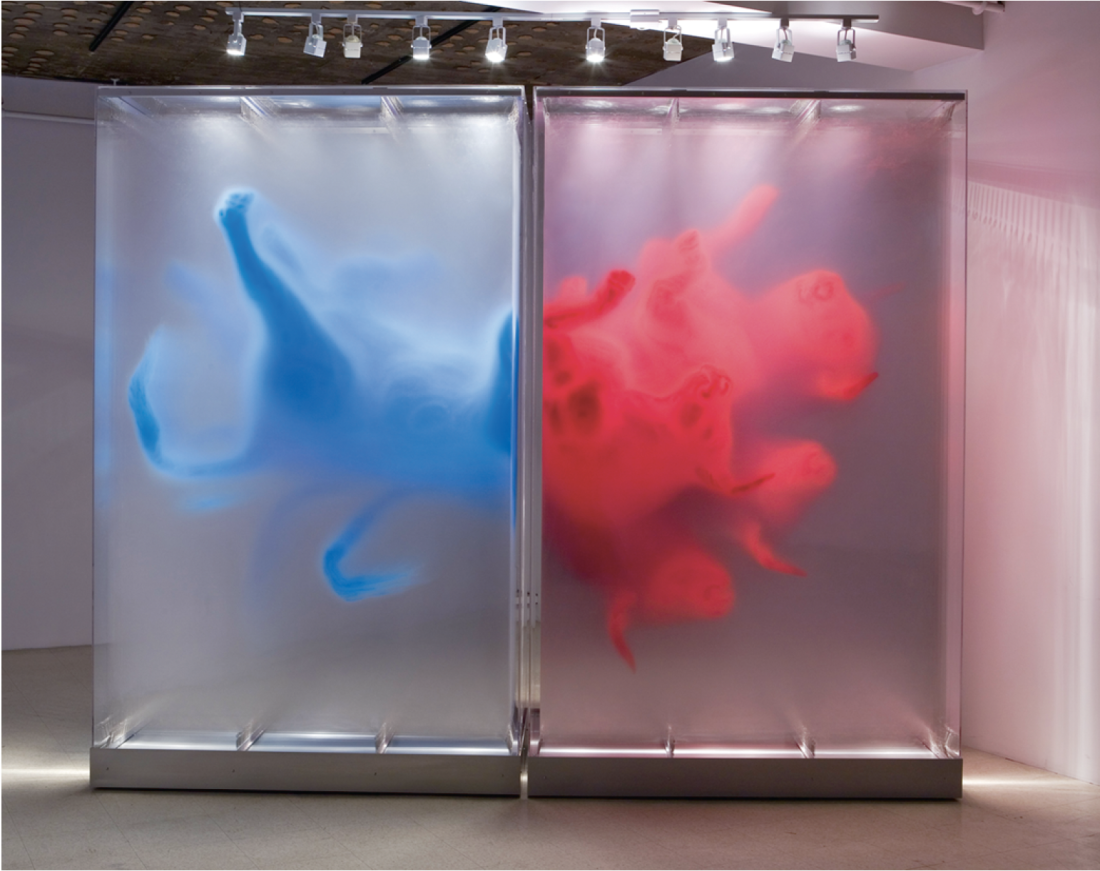David Spriggs
It’s unpopular to mention Modernism these days. It’s as if we are living in an ahistorical bubble while the world’s infrastructures are collapsing and everything in the art world, no matter how inane, is celebrated as new and exciting. In this moment of what could be called art light, thinking may be out of fashion. The superficiality of surface seems to preside over most exhibitions, the artist’s voice reduced to a pathetic mumble while the academy, the market and the party roar on. In this unsympathetic milieu, David Spriggs is a young artist who wants to ramp it up a bit and actually say something serious.
Paradox of Power is the title of the single work that makes up his exhibition at Montreal’s Art Mûr. The piece is large, measuring 10’ by 8’ and about 2’ deep. Made of layers of hanging transparent Mylar sheets with an image airbrushed onto them, it reads like an analog hologram. It appears to be a floating three-dimensional form but is actually stratified layers. Seen from the front, there’s a sense of a volumetric form; from the side, the volume is lost to vertical painted layers. The image is an upside-down bull caught in a running motion; there are four moments in the bull’s action superimposed onto one another. It’s difficult to describe the work and it’s the walk around the piece that brings it to life and gives it a frenzied sense of movement. The bull is cut vertically in half, one side painted red, the other blue.

David Spriggs, The Paradox of Power, 2007, sprayed acrylic paint on multiple sheets of transparent fi lm in display case. Photo: Guy L’Heureux.
As a point of historical reference, Spriggs situates his work in relation to a number of modernist moments—in particular, Cubism and Italian Futurism and the desire to render movement visible in the plastic arts. You could also think of Duchamp’s Nude Descending a Staircase. But Spriggs is working in the 21st century. He knows about the great wars, the nuclear threat and global warming. He isn’t glorifying progress by tearing down the past because, unlike the Futurists, he knows the consequences.
Paradox of Power operates on several levels. Firstly, it’s a stunning visual statement. Spriggs has mastered his technique and, in this work, pushes it to its limits. The bull itself is a powerful image, and upside down, it has an urgency about it, like you’re watching a bug flipped on its back, trying to right itself. Could it be Picasso’s bull, the great male, rendered impotent and helpless? Cut in half and turned into monochromes, the illusion of sculptural form is twisted into a reference to painting and to the heroic modernist gesture. The work is sculptural, while being many two-dimensional paintings, and it contradicts itself. The illusion is a trick and power is relative. It depends on there being a “powerless.” Movement cannot exist without stillness; one depends on the presence of the other. Maybe the paradox is the inevitable state of being. This work makes me feel like I’m caught in the middle, being pulled back and forth by layers of potential meaning; acknowledging that middle place, the blur between one point and another, is, perhaps, the intent of the work.
Ambitious both in technique and in the artist’s intentions, Paradox of Power is impressive and, it should be said, beautiful. The technique is not without its limitations, but every medium has its problems. The Mylar can only be so large, it collects dust, it gets scratched, and so on. But I don’t think it matters. Spriggs is taking the practice of making art seriously. His Mylar pieces create a sense of wonder in the viewer. He’s out there, making standalone work, and taking technical risks while trying to take on the big issues. His art is continuing to develop and, as he gets closer to a technique that equals his aspirations, there will be some impressive work to look forward to. ■
David Spriggs’s “The Paradox of Power / Le paradoxe du pouvoir” was exhibited at Galerie Art Mûr in Montreal from April 26 to May 26, 2007.
Randall Anderson is an artist and writer living in Montreal. He recently received a commission for a public sculpture at Concordia University’s Fine Arts building.

